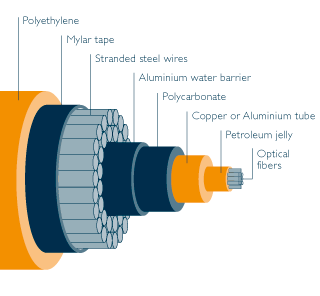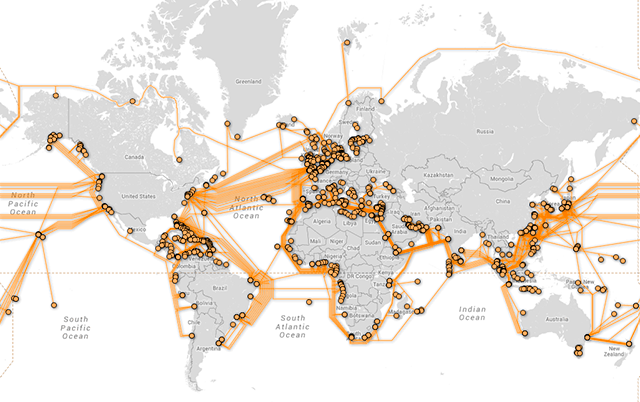The underwater world is nothing less than science fiction – with due respect to the flora and fauna – it’s the matrix of fiber optics orbiting the earth that transports you to a world of cabled mystery! And this real submarine world was created much before the Wachowski siblings came up with the idea of a virtual supernatural world.
We are all aware of the cables that run through our houses, offices, along the roads – ensuring we are connected online all the time. But here’s a surprising fact – the overseas satellite links account for only 1% of the world’s total traffic. Hats off to the unsung heroes, the remaining traffic flows through the undersea cables [as of 2006].

Unwrapping the layers of a submarine cable
So what exactly are these ocean cables made of? As you transverse through the various layers, typically you will first encounter the polyethylene on top, followed by a Mylar tape, stranded steel wires, aluminium water barrier, polycarbonate, copper tube, petroleum jelly, until you finally reach the optical fibers. The 8 layers combined are only 2-3 inches thick – with total capacity ranging from 40Gbps – 16Tbps.
A “snap” is all it takes to enter the dark ages
Of all the things you can blame cable faults on, fancy accusing a shark! Other contributors to ocean cable fault are earthquakes and currents. But largest threats come from trawlers that drag the cables along with the fishing net, and from ships that do not anchor properly. Considering the expense and time devoted to mend a snap, all submarine cables are marked on the navigation map – an area where trawling and anchoring is not allowed. Unfortunately, regardless of all precautions, cable snaps are inevitable.
Undersea repair process
Repairing a submarine cable is not exactly a snorkeling or scuba diving experience. It takes precise calculation with the use of a reflectometer, dependency on mechanical robots, and specialized cable-laying ships. To locate the fault area, light pulses are sent along the cable – at the site of damage, the signal rebounds. The split ends of the cable are retrieved onboard with the use of an underwater robot or a grapnel (anchor or hook). Technicians onboard remove the damaged part, add new cable to reconnect the split ends, test it, and immerse it back into the ocean bed.
However, it’s not an immediate procedure – it relies on the accessibility of these specialized cable ships. There are only a few globally, placed at strategic locations where cable density is high. Also, ice cover and stormy weather hinders the repair process – sometimes the wait stretches from days to weeks.
Densely populated ocean cable routes
The cables are most concentrated around the South and West European coasts (along the English Channel), both ends of the Suez Canal, the South and East coasts of Asia, the Caribbean coast, and the East and West American coast. To see where these cables are laid around the world, you can visit either Greg’s Cable Map and Submarine Cable Map.

Considering our global footprint, we use submarine cables throughout the world. To ensure continued connectivity to our users, we use multiple redundant lines for a single route. Each line, equipped with 10GE capacity, has excess space capacity. During a cable fault, the traffic of the affected cable is instantly shared across the remaining cables. This ensures congestion-free connectivity, after rerouting has taken place, even when the repair takes days, weeks or months.
Ruslan Abuzant
September 16, 2013 at 13:20This is how we plan our server locations actually, to ensure lower [ms] times and more reachability routes to desired destinations.
Cam Ranh Airport to Hotel
July 4, 2018 at 8:03I feel these installation methods or structure is very good quality of the transmission line, its quality always guarantees the transmission.